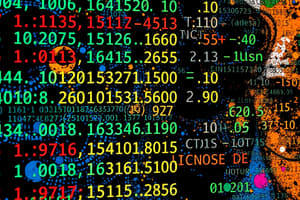Podcast
Questions and Answers
Which measurement should be used specifically for numeric attributes to describe central tendency?
Which measurement should be used specifically for numeric attributes to describe central tendency?
- Median
- Range
- Mean (correct)
- Mode
In which situation would you use the Jaccard coefficient for dissimilarity measurement?
In which situation would you use the Jaccard coefficient for dissimilarity measurement?
- When assessing similarity between nominal attributes
- When comparing objects with ordinal attributes
- When examining binary attributes (correct)
- When analyzing numeric attributes
What is the primary function of a correlation matrix?
What is the primary function of a correlation matrix?
- To normalize numeric data
- To display the central value of attributes
- To measure dissimilarity between objects
- To identify redundancy and correlation among variables (correct)
Which type of attributes can be described with symmetric/asymmetric binary dissimilarity?
Which type of attributes can be described with symmetric/asymmetric binary dissimilarity?
What is the primary goal of schema integration in the entity identification problem?
What is the primary goal of schema integration in the entity identification problem?
What is the main goal of attribute subset selection in data reduction strategies?
What is the main goal of attribute subset selection in data reduction strategies?
Which of the following sampling methods allows tuples to be drawn more than once?
Which of the following sampling methods allows tuples to be drawn more than once?
What is the primary objective of regression in data analysis?
What is the primary objective of regression in data analysis?
Which dimensionality reduction technique involves transforming data to a compressed representation?
Which dimensionality reduction technique involves transforming data to a compressed representation?
What type of sampling generates a sample by dividing tuples into groups and selecting complete groups randomly?
What type of sampling generates a sample by dividing tuples into groups and selecting complete groups randomly?
Flashcards
Numeric Data Normalization
Numeric Data Normalization
A process that ensures all numerical attributes in a dataset have equal weight during similarity calculations.
Minkowski Distance
Minkowski Distance
A method to measure similarity/dissimilarity between objects with numerical attributes.
Attribute Types
Attribute Types
Categorize attributes as nominal, binary, ordinal, or numerical, guiding similarity/dissimilarity calculations.
Nominal Attributes
Nominal Attributes
Signup and view all the flashcards
Binary Attributes
Binary Attributes
Signup and view all the flashcards
Central Tendency
Central Tendency
Signup and view all the flashcards
Metadata
Metadata
Signup and view all the flashcards
Entity Identification Problem
Entity Identification Problem
Signup and view all the flashcards
Correlation Matrix
Correlation Matrix
Signup and view all the flashcards
Data Reduction
Data Reduction
Signup and view all the flashcards
Dimensionality Reduction
Dimensionality Reduction
Signup and view all the flashcards
Numerosity Reduction
Numerosity Reduction
Signup and view all the flashcards
Parametric Method
Parametric Method
Signup and view all the flashcards
Nonparametric Method
Nonparametric Method
Signup and view all the flashcards
Attribute Subset Selection
Attribute Subset Selection
Signup and view all the flashcards
Attribute Construction
Attribute Construction
Signup and view all the flashcards
Regression
Regression
Signup and view all the flashcards
Regression Line Equation
Regression Line Equation
Signup and view all the flashcards
Sampling
Sampling
Signup and view all the flashcards
SRSWOR
SRSWOR
Signup and view all the flashcards
SRSWR
SRSWR
Signup and view all the flashcards
Cluster Sample
Cluster Sample
Signup and view all the flashcards
Stratified Sample
Stratified Sample
Signup and view all the flashcards
Study Notes
Data Dissimilarity and Normalization
- Numeric data dissimilarity requires normalization to equalize attribute weights.
- Example: Height (meters) and weight (grams) attributes. One will likely dominate due to different scales.
Measuring Data Similarity/Dissimilarity
- Attributes can be nominal, binary, ordinal, or numeric.
- Use mean, SD, median, and mode to measure numeric attribute central tendency.
- Use median and mode for other attributes.
- Use:
- Matching percent for nominal attributes.
- Symmetric/asymmetric binary dissimilarity or Jaccard coefficient for binary attributes.
- Minkowski distance for numeric attributes.
Entity Identification Problem
- Schema integration and object matching.
- Metadata (name, meaning, data type, permissible range, and null rules) helps avoid integration and data transformation errors.
Data Reduction Strategies
- Dimensionality Reduction: Reduce the number of attributes; methods include wavelet transforms and Principal Component Analysis (PCA). Also attribute subset selection.
- Numerosity Reduction: Replace original data with smaller data representation.
- Parametric: Estimate data using only parameters.
- Nonparametric: Store reduced representations of the data.
- Compression: Transformations for "compressed" representation.
- Attribute SubsetSelection: Determine a minimal set of attributes to maintain the original data distribution.
- Attribute Construction: Create new attributes, e.g., area from height and width.
Regression
- Modeling data for fitting a straight line.
- Regression line equation: y = wx + b (w and b are regression coefficients).
- Calculated using least squares method (minimizing error between actual and estimated lines)
Sampling
- Represent a large dataset using a smaller, random sample.
- Simple Random Sample (SRS):
- Without replacement (SRSWOR): Draw 's' of 'N' tuples ('s' < 'N').
- With replacement (SRSWR): Similar to SRSWOR but each drawn tuple is recorded, then replaced for possible reuse.
- Cluster Sampling: Tuples are grouped into clusters, and an SRS of clusters is obtained.
- Stratified Sampling: Tuples are divided into strata and SRS is generated within each stratum.
Studying That Suits You
Use AI to generate personalized quizzes and flashcards to suit your learning preferences.



